Caryn’s Thoughts
 My youngest sister, Allyn Hadlock has always been the sweetest one of us all, and I don’t say that to sound like the rest of us are horrible hags, because that isn’t the case at all. It’s just that if you ask any one of my other three sisters or me, what one thing we all agreed on concerning Allyn, it was that “Allyn was always good.” As a little girl, our mom couldn’t spank or even yell at Allyn, because she would become so broken hearted…when Mom simply told her no-no. Allyn just has a very tender heart, to this day. Being tender hearted can have it’s really good side too. Allyn has a kind way about her, and it is not something that goes unnoticed in any setting. Everyone notices her kindness and sweet ways.
My youngest sister, Allyn Hadlock has always been the sweetest one of us all, and I don’t say that to sound like the rest of us are horrible hags, because that isn’t the case at all. It’s just that if you ask any one of my other three sisters or me, what one thing we all agreed on concerning Allyn, it was that “Allyn was always good.” As a little girl, our mom couldn’t spank or even yell at Allyn, because she would become so broken hearted…when Mom simply told her no-no. Allyn just has a very tender heart, to this day. Being tender hearted can have it’s really good side too. Allyn has a kind way about her, and it is not something that goes unnoticed in any setting. Everyone notices her kindness and sweet ways.
Over the years, Allyn has done her very best to always make those around her feel  loved and blessed. She had special nicknames for her kids, and songs using their name that she either made up or replaced a name in a song with theirs. One thing her kids could always count on is that their mom was going to put a smile on their face every day. We all felt that way, so I know what I am talking about.
loved and blessed. She had special nicknames for her kids, and songs using their name that she either made up or replaced a name in a song with theirs. One thing her kids could always count on is that their mom was going to put a smile on their face every day. We all felt that way, so I know what I am talking about.
Other than being married to her husband, Chris Hadlock and having her children, Jessi Sawdon, Ryan Hadlock, Lindsay Moore, and Kellie Hadlock, I think that the greatest blessings in recent years have come in the form of her children’s spouses, Jason Sawdon, Chelsea Hadlock, and Shannon Moore, and now the beautiful little grandbabies she has, Ethan Hadlock, Aurora Hadlock, and Adelaide Sawdon. These days the little name songs have the names of those  precious babies in them, and Allyn makes sure that each of those babies knows that they are just the sweetest one, and while it might seem odd that each one could be the sweetest one, in the world of a grandma, that is totally possible. Grandmas love each baby the most, no matter how many there are. That’s because we love each one the same…100%. Allyn is as blessed as a woman can be, and she is still thought of as the sweetest one. In fact, that very thing came up last night when I was at our sister Cheryl’s house and we were talking. We all agreed that Allyn was always good. Today is Allyn’s birthday. Happy birthday Allyn!! Have a great day!! We love you!!
precious babies in them, and Allyn makes sure that each of those babies knows that they are just the sweetest one, and while it might seem odd that each one could be the sweetest one, in the world of a grandma, that is totally possible. Grandmas love each baby the most, no matter how many there are. That’s because we love each one the same…100%. Allyn is as blessed as a woman can be, and she is still thought of as the sweetest one. In fact, that very thing came up last night when I was at our sister Cheryl’s house and we were talking. We all agreed that Allyn was always good. Today is Allyn’s birthday. Happy birthday Allyn!! Have a great day!! We love you!!
 My grand nephew, Jake Harman has gone through some life changing events over the past few years. He got married to a wonderful girl named Melanie, and gained a sweet daughter, named Alice Green, who was Melanie’s daughter from a previous relationship. Then, they had another sweet daughter, named Izabella Siara. What more could a man ask for…right? Well, in Jake’s case, it would be the son who will be joining the family soon. I don’t think they thought they would get a boy, but they are very excited that they are. For Jake, it’s like a dream. He has wanted to have a family for quite some time now, and suddenly, he finds himself living right in the middle of the very dream he had in mind. It is such a cool thing, to watch your dreams come true.
My grand nephew, Jake Harman has gone through some life changing events over the past few years. He got married to a wonderful girl named Melanie, and gained a sweet daughter, named Alice Green, who was Melanie’s daughter from a previous relationship. Then, they had another sweet daughter, named Izabella Siara. What more could a man ask for…right? Well, in Jake’s case, it would be the son who will be joining the family soon. I don’t think they thought they would get a boy, but they are very excited that they are. For Jake, it’s like a dream. He has wanted to have a family for quite some time now, and suddenly, he finds himself living right in the middle of the very dream he had in mind. It is such a cool thing, to watch your dreams come true.
 Jake’s daughters think he pretty much hung the moon, and their eyes light up when he is home. I love the pictures of him with the girls, because you can just see the joy and happiness in their faces. And, I can picture how things will be in the future. Jake and his son outside playing catch, or some other sport, and the girls will be the cheerleaders. There is a contentment that will dwell over their house…until the teenage years hit anyway. I have to wonder if Jake will be the kind of dad, who is sure that no guy is good enough for his girls, and remember that these are beautiful girls, so there will be no shortage of guys wanting to take them out for the evening. But, I suppose that is a story for another day. For now, Jake gets to enjoy the
Jake’s daughters think he pretty much hung the moon, and their eyes light up when he is home. I love the pictures of him with the girls, because you can just see the joy and happiness in their faces. And, I can picture how things will be in the future. Jake and his son outside playing catch, or some other sport, and the girls will be the cheerleaders. There is a contentment that will dwell over their house…until the teenage years hit anyway. I have to wonder if Jake will be the kind of dad, who is sure that no guy is good enough for his girls, and remember that these are beautiful girls, so there will be no shortage of guys wanting to take them out for the evening. But, I suppose that is a story for another day. For now, Jake gets to enjoy the  childhood years and just how perfect his life is at this moment.
childhood years and just how perfect his life is at this moment.
It hard for me to believe that Jake is not only grown up, but a family man, but it isn’t hard at all to see why he picked Melanie to be his bride, however. She is so sweet, and they just compliment each other perfectly. She really is his soul mate, and the love of his life. I love to watch them together, because they are so cute. Jake, like most men, will probably never grow up, but Melanie loves him just the way he is, so that’s ok. Their dream life is moving full steam ahead, and I am so happy for them. Life is good, and we can’t wait to meet their little boy!! Today is Jake’s birthday. Happy birthday Jake!! Have a great day!! We love you!!

 My second cousin twice removed, Hazel Grace Pallas, daughter of Angel and Brian Pallas, is quite a character. I have only met Hazel and her family via Facebook, but her mom and her aunt, Elizabeth Nordquist, have posted a lot of pictures of the kids, and along with the stories they provide, I feel like I’ve known their kids forever. As I said, Hazel is a character, but she is also a Girly Girl, and could even be classed as a Diva, but that isn’t surprising, because she spends a lot of time with her cousins, Addilayde and Meadow Nordquist, daughters of Elizabeth and Aron Nordquist, and they can definitely be Divas.
My second cousin twice removed, Hazel Grace Pallas, daughter of Angel and Brian Pallas, is quite a character. I have only met Hazel and her family via Facebook, but her mom and her aunt, Elizabeth Nordquist, have posted a lot of pictures of the kids, and along with the stories they provide, I feel like I’ve known their kids forever. As I said, Hazel is a character, but she is also a Girly Girl, and could even be classed as a Diva, but that isn’t surprising, because she spends a lot of time with her cousins, Addilayde and Meadow Nordquist, daughters of Elizabeth and Aron Nordquist, and they can definitely be Divas.
While these girls can be girly and artsy, they also love to play, and they have a great time together; as well as with Hazel’s little sister, Tenley; and their cousins, Hosea and Canaan Oltman, sons of Grace and Tzaddik 
 Oltman. It’s so much fun to look at the great pictures of these close families of cousins. The moms take pictures often, especially Elizabeth, who is a photographer in her own right, so I have watched these kids grow up almost all of their lives.
Oltman. It’s so much fun to look at the great pictures of these close families of cousins. The moms take pictures often, especially Elizabeth, who is a photographer in her own right, so I have watched these kids grow up almost all of their lives.
Addi and Meadow, being the oldest ones, inspire all the fun around there. They play with all the kids, and really enjoy having their cousins come over. The other day, the three older girls, Addi, Meadow, and little Hazel were out in the back yard, playing in the snow. For Hazel, who is 2½ years old, I think this is still a very new experience. Nevertheless, it is one she very much enjoyed. The girls got out anything the could slide on, and they had a wonderful time slipping and sliding on the snow. When Hazel told her mom about all she did that afternoon, she simple 
 summed it up as, “Swimming in the snow, Mom!” When I read that comment, I just laughed and laughed. It was perfect. To have that childhood enjoyment of the snow…untainted by the experiences of driving in the snow, and all the stress that comes with it…seemed like a dream world to me. As I was driving to work this morning, with little Hazel on my mind, I noticed that as I drove down the alley from my backyard garage, over the freshly fallen snow, it felt like I was almost floating along. Hazel’s words came to my mind. “Swimming in the snow, Mom!” I think I know how Hazel felt.
summed it up as, “Swimming in the snow, Mom!” When I read that comment, I just laughed and laughed. It was perfect. To have that childhood enjoyment of the snow…untainted by the experiences of driving in the snow, and all the stress that comes with it…seemed like a dream world to me. As I was driving to work this morning, with little Hazel on my mind, I noticed that as I drove down the alley from my backyard garage, over the freshly fallen snow, it felt like I was almost floating along. Hazel’s words came to my mind. “Swimming in the snow, Mom!” I think I know how Hazel felt.
 Most people know that with an earthquake underwater, comes the possibility of a tsunami. Tsunamis can cause as much or more damage that the original earthquake. I think we all know that living in a coastal area puts the residents in possible danger when these offshore earthquakes hit, but what happens further inland? The tsunami doesn’t normally travel too far inland…unless it is a fluvial tsunami. This was a type of tsunami I had never heard of before. Nevertheless, on this day, February 7, 1812, there was a series of earthquakes in Missouri. They were the most violent and powerful quakes in the history of the United States. The series of tremors, which took place between December 1811 and March 1812. The Seismic activity was quite unusual for the area around the city of New Madrid, located near the Mississippi River in present day Arkansas, which had about 1,000 residents at the time, most of whom were farmers, hunters, and fur trappers. It all began on December 15, 1811with unusual tremors. Then, at 7:15am, an even more powerful quake erupted, now estimated to have been an 8.6 magnitude quake. This quake literally knocked people off their feet and many people experienced nausea from the extensive rolling of the earth. Given that the area was sparsely populated and there weren’t many multi-story structures, the death toll was relatively low. However, the quake did cause landslides that destroyed several communities, including Little Prairie, Missouri.
Most people know that with an earthquake underwater, comes the possibility of a tsunami. Tsunamis can cause as much or more damage that the original earthquake. I think we all know that living in a coastal area puts the residents in possible danger when these offshore earthquakes hit, but what happens further inland? The tsunami doesn’t normally travel too far inland…unless it is a fluvial tsunami. This was a type of tsunami I had never heard of before. Nevertheless, on this day, February 7, 1812, there was a series of earthquakes in Missouri. They were the most violent and powerful quakes in the history of the United States. The series of tremors, which took place between December 1811 and March 1812. The Seismic activity was quite unusual for the area around the city of New Madrid, located near the Mississippi River in present day Arkansas, which had about 1,000 residents at the time, most of whom were farmers, hunters, and fur trappers. It all began on December 15, 1811with unusual tremors. Then, at 7:15am, an even more powerful quake erupted, now estimated to have been an 8.6 magnitude quake. This quake literally knocked people off their feet and many people experienced nausea from the extensive rolling of the earth. Given that the area was sparsely populated and there weren’t many multi-story structures, the death toll was relatively low. However, the quake did cause landslides that destroyed several communities, including Little Prairie, Missouri.
The quake also caused fissures…some as much as several hundred feet long…to open on the earth’s surface. Large trees were snapped in two. Sulfur leaked out from underground pockets and river banks vanished, flooding thousands of acres of forests. On January 23, 1812, an estimated 8.4-magnitude quake struck in 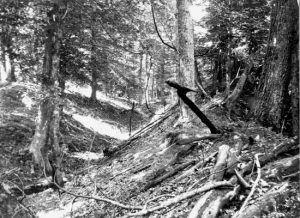 nearly the same location, causing disastrous effects. Reportedly, the president’s wife, Dolley Madison, was awoken by the quake in Washington, DC. The death toll was smaller for this quake, because most of the survivors of the first earthquake were now living in tents, so they could not be crushed. The strongest of the tremors followed on February 7, 1812, and was estimated at an amazing 8.8 magnitude…probably one of the strongest quakes in human history. Church bells rang thousands of miles away in Boston, Massachusetts, from the shaking. Brick walls were toppled in Cincinnati, Ohio. In the Mississippi River, water turned brown and whirlpools developed suddenly from the depressions created in the riverbed. Waterfalls were created in an instant and in one report, 30 boats were helplessly thrown over falls, killing the people on board. Many of the small islands in the middle of the river, often used as bases by river pirates, permanently disappeared…possibly a poetic end to their crimes. Large lakes, such as Reelfoot Lake in Tennessee and Big Lake at the Arkansas-Missouri border, were created by the earthquake as river water poured into new depressions in the ground. But, probably the most unusual activity, was what happened to the Mississippi River next. Because of the quake’s proximity to the Mississippi River, the quake had an effect that was probably unheard of until that time…a Fluvial Tsunami. A Fluvial Tsunami is something I never knew existed, but apparently it does. The quake and the ensuing fluvial tsunami in the Mississippi River, actually made the river run backward for several hours. I’m sure people were stunned and frightened at what they saw.
nearly the same location, causing disastrous effects. Reportedly, the president’s wife, Dolley Madison, was awoken by the quake in Washington, DC. The death toll was smaller for this quake, because most of the survivors of the first earthquake were now living in tents, so they could not be crushed. The strongest of the tremors followed on February 7, 1812, and was estimated at an amazing 8.8 magnitude…probably one of the strongest quakes in human history. Church bells rang thousands of miles away in Boston, Massachusetts, from the shaking. Brick walls were toppled in Cincinnati, Ohio. In the Mississippi River, water turned brown and whirlpools developed suddenly from the depressions created in the riverbed. Waterfalls were created in an instant and in one report, 30 boats were helplessly thrown over falls, killing the people on board. Many of the small islands in the middle of the river, often used as bases by river pirates, permanently disappeared…possibly a poetic end to their crimes. Large lakes, such as Reelfoot Lake in Tennessee and Big Lake at the Arkansas-Missouri border, were created by the earthquake as river water poured into new depressions in the ground. But, probably the most unusual activity, was what happened to the Mississippi River next. Because of the quake’s proximity to the Mississippi River, the quake had an effect that was probably unheard of until that time…a Fluvial Tsunami. A Fluvial Tsunami is something I never knew existed, but apparently it does. The quake and the ensuing fluvial tsunami in the Mississippi River, actually made the river run backward for several hours. I’m sure people were stunned and frightened at what they saw.
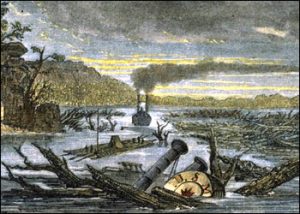
The exact death toll from this series of deadly quakes is difficult to determine because of a lack of an accurate record of the Native American population in the area at the time. The series of quakes ended in March of 1812, with aftershocks continuing for years. In the end, it was decided that approximately 1,000 people died because of the quakes, but it could be much higher. As I researched this crazy tsunami, I found out that fluvial refers to a river tsunami, the Mississippi River has actually flowed backward multiple times, and fluvial tsunamis are actually not that rare, they occur whenever a quake causes the water in a river to flow backward it rush in is normal direction.
 My niece, Jenny Spethman is a woman of many talents. She is first and foremost a woman of God, who loves the Lord with all her heart. Life has not always been a bed of roses for Jenny, but through it all, she and her husband, Steve made God their center, and He has given then the strength to weather the storms that life brings…and some of these were hurricanes or tornadoes. Most weren’t literally that type, but they did fly through the edge of a hurricane on their way to their honeymoon, so they learned to trust God very early on in their marriage. The loss of their daughter, Laila at 22 days old, is something that would have ripped many a marriage apart, but not Jenny and Steve. They pressed into the Lord, and learned to seek His comfort in all the sad days that followed her passing. God has carried them through…every storm.
My niece, Jenny Spethman is a woman of many talents. She is first and foremost a woman of God, who loves the Lord with all her heart. Life has not always been a bed of roses for Jenny, but through it all, she and her husband, Steve made God their center, and He has given then the strength to weather the storms that life brings…and some of these were hurricanes or tornadoes. Most weren’t literally that type, but they did fly through the edge of a hurricane on their way to their honeymoon, so they learned to trust God very early on in their marriage. The loss of their daughter, Laila at 22 days old, is something that would have ripped many a marriage apart, but not Jenny and Steve. They pressed into the Lord, and learned to seek His comfort in all the sad days that followed her passing. God has carried them through…every storm.
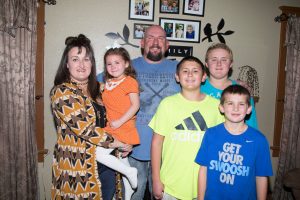
Jenny loves being a wife and mother. Her family is her everything. She attends the boys, Xander, Zack, and Isaac’s sporting events, and her daughter, Aleesia’s girly events, like dancing, cheerleading. With the boys in school all day, Jenny and Aleesia have had more time to spend doing girly time. The sad thing is that now, Aleesia is almost ready for full time school too, so Jenny is in the process of deciding who she will be then. I have been in that situation too, so I understand how that feels. When you are no longer a full time caregiver, as in my case, or a full time mommy, as in Jenny’s case, you start to think, “Ok, then who am I?” It’s a question every mom has to answers at some point.

The reality is that everyone has these moments when they need to basically re-invent themselves. Jenny is trying to decide now, if she will go back to school or go to work. I totally understand the vast array of feelings she has about this. She will miss being the stay-at-home mom, with all the kids around her, but there is a type of excitement that comes with a new adventure, be it work or study. All new adventures are often bittersweet…exciting on the one side, but sad too, because you are leaving the time of your children’s babyhood behind. Bittersweet as it may be, I know that Jenny will weather this storm just fine too. Today is Jenny’s birthday. Happy birthday Jenny!! Have a great day!! We love you!!
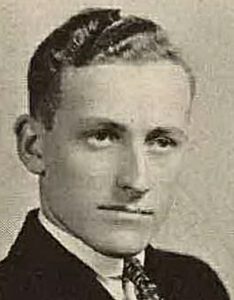 Early in my married life, I met a precious part of my husband, Bob’s family, in the form of his great grandparents, Edgar and Nellie Knox; his great aunt and uncle, Helen and Frank Knox; and their youngest son, Richard. They were wonderful people, and I loved them right away. I always thought it was awesome of Frank and Helen to bring their parents out to Casper to visit their son, Bob Knox’s family, of which I was a part. At that time, I didn’t really have a lot of time to get to know Frank and Helen, but got to know them on subsequent trip, and found them to be very interesting…but, little did I know, that I had only scratched the surface of who these people were.
Early in my married life, I met a precious part of my husband, Bob’s family, in the form of his great grandparents, Edgar and Nellie Knox; his great aunt and uncle, Helen and Frank Knox; and their youngest son, Richard. They were wonderful people, and I loved them right away. I always thought it was awesome of Frank and Helen to bring their parents out to Casper to visit their son, Bob Knox’s family, of which I was a part. At that time, I didn’t really have a lot of time to get to know Frank and Helen, but got to know them on subsequent trip, and found them to be very interesting…but, little did I know, that I had only scratched the surface of who these people were.
After Helen’s passing recently, I found out so much more about her childhood, and the life she and Frank lived. In many ways, it was destiny that they should meet. Helen’s family had moved to California because of her mother’s illness, and after her mother passed away, the three older children were raised by her mother’s sister, while her younger siblings were adopted out. It was a sad time for Helen, but when she grew up, she decided to earn a degree in Social Work. When World War II finally drew the United States into it’s clutches, Helen became active in the USO, and it was then, during a homecoming dance, that she met a handsome young captain, named Richard F (Frank) Knox. They were smitten with each other right away, and married on June 13, 1946.
It was time then for Frank to go to college, so they moved to Pullman, Washington and he attended Washington State College, now Washington State University. When he graduated, Frank and Helen had planned to move to Vanport, Washington for a job he had lined up, with the Clark County PUD in Vancouver, WA, but the Vanport Flood of May 30, 1948 ended that dream. The flood wiped out the up and coming town of Vanport, Oregon, leaving no housing for Frank and Helen. It was then that Frank took an instructor position in Pullman, Washington, and that was where he and Helen lived for the next 40 years, and raised their five sons, Robert, David, Greg, Wesley, and Richard. I find it amazing, how God can have a different plan for us than our plan. I 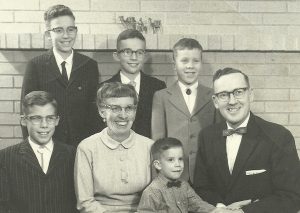 don’t know how things might have worked out had the flood not happened, but Frank and Helen and their sons lived a wonderful life in Pullman, Washington.
don’t know how things might have worked out had the flood not happened, but Frank and Helen and their sons lived a wonderful life in Pullman, Washington.
With Helen’s passing, comes a new kind of loneliness for Frank, and I am glad that he has his wonderful sons and their families to help him get through this difficult time. Nothing will ever replace the love of his life, and I’m sure that this…the first birthday without he beloved soul mate, Helen, will be a difficult on for Frank, and I will be keeping him in prayer today and always, that the Lord with comfort him all the days of his life. Today is Frank’s 97th birthday. Happy birthday Frank!! Have a great day!! We love you!!
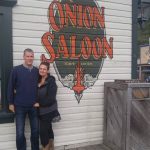
 My nephew, Dave Chase, who married my niece Toni on December 18, 2012, loves to travel. It is a passion they both share. A lot of their travel time includes hiking or ball games, but the trip they took this last fall was a little bit different. They were taking a trip that would take them to the same places that Toni’s grandparents, my parents, Al and Collene Spencer, had gone…Alaska. It was my parents dream trip, and Toni wanted to take it too. Dave was totally on board…literally, in fact, since it was a cruise, after all. They took the same cruise my parents had gone and had a wonderful time.
My nephew, Dave Chase, who married my niece Toni on December 18, 2012, loves to travel. It is a passion they both share. A lot of their travel time includes hiking or ball games, but the trip they took this last fall was a little bit different. They were taking a trip that would take them to the same places that Toni’s grandparents, my parents, Al and Collene Spencer, had gone…Alaska. It was my parents dream trip, and Toni wanted to take it too. Dave was totally on board…literally, in fact, since it was a cruise, after all. They took the same cruise my parents had gone and had a wonderful time.
Some of Dave’s family joined them for the cruise, including his brother, Dan. These guys are both very competitive, and so naturally they entered every contest on the cruise ship. Trivia, bean bag toss, basketball, golf…you name it, they got in on it. And not only did they get in on it, the won almost every contest they entered. At first everyone was great about it, but by the end of the cruise, there were a number of people who did not like them, because of it. What do you do…sit out the fun because someone might get upset. In the end, they took home seven trophies…with they call “Our Little Golden Ships.” I guess I find it hard to think that people didn’t like the brothers, because while I don’t personally know Dan, I do know Dave, and I would find it impossible not to like Dave.
Dave and Toni are so perfect together. The are active, and outgoing. Dave is so supportive in the business Toni has started, and he runs any errands she needs done, and helps with the shipping. He is a hard worker, and is 
 willing to help out whenever he is asked to. The day Dave married into this family, he took that to mean that he was a full fledged part of it, and all that entailed. He is right of course, he is a full fledged part of the family, but he takes that to mean more…such as taking on any of the responsibilities that go along with being a family member. Not everyone who marries into a family feels that way, but that is something I have seen in Dave from the very start, and it makes me very proud to call him my nephew. Today is Dave’s birthday. Happy birthday Dave!! Have a great day!! We Love you!!
willing to help out whenever he is asked to. The day Dave married into this family, he took that to mean that he was a full fledged part of it, and all that entailed. He is right of course, he is a full fledged part of the family, but he takes that to mean more…such as taking on any of the responsibilities that go along with being a family member. Not everyone who marries into a family feels that way, but that is something I have seen in Dave from the very start, and it makes me very proud to call him my nephew. Today is Dave’s birthday. Happy birthday Dave!! Have a great day!! We Love you!!
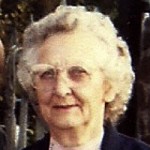 I never had a problem remembering Grandma Hein’s birthday. Grandma is my husband, Bob’s grandmother, so I didn’t grow up knowing her birthday. Nevertheless, I always can always remember that day. I suppose it is because, every year, Grandma had a special date with a ground hog. Everyone has dates…and I don’t mean the romantic kind. There is a date with death, a date with birth, a date with an upcoming test, or graduation. We don’t always call these things dates, although, some of them we do. And every year, we have a date with our birthday. That was the kind of date that Grandma Hein had. Every year of her life, Grandma knew that her day was extra special, because she got to find out about the coming Spring. She mentioned that to me several times, so I know she liked it.
I never had a problem remembering Grandma Hein’s birthday. Grandma is my husband, Bob’s grandmother, so I didn’t grow up knowing her birthday. Nevertheless, I always can always remember that day. I suppose it is because, every year, Grandma had a special date with a ground hog. Everyone has dates…and I don’t mean the romantic kind. There is a date with death, a date with birth, a date with an upcoming test, or graduation. We don’t always call these things dates, although, some of them we do. And every year, we have a date with our birthday. That was the kind of date that Grandma Hein had. Every year of her life, Grandma knew that her day was extra special, because she got to find out about the coming Spring. She mentioned that to me several times, so I know she liked it.
Grandma’s life wasn’t always easy. Her mother, Viola Leary, was in and out of their lives, and when she returned, Grandma wasn’t sure she wanted her there. Of course, there was a step mother in the picture at some point, but that marriage didn’t last either, opening the door for Viola’s return. Viola was back in Grandma’s life until her dad’s passing, and then resurfaced at the time of her own passing. Unfortunately, Grandma’s relationship with her mother was never an especially close one, even when her mother lived with them. Of course, I also understand that there are two sides to every story, but since everyone else had passed away, I only heard the one side.
Grandma was a hard working woman. I’m sure that is partly because of all the years she spent taking care of the house that she and her dad and brother lived in. I remember going to her home for visits, and finding  myself thinking that Grandma just never slowed down. She could run circles around most people and never seemed to get tired. I think that is how most ranchers’ wives are though. The day just never seems to end.
myself thinking that Grandma just never slowed down. She could run circles around most people and never seemed to get tired. I think that is how most ranchers’ wives are though. The day just never seems to end.
It was always so much fun to go to visit Grandma and Grandpa Hein. It was a trip we made sure we took every year, and I have always be thankful we did. It has been so many years, and I really miss those trips and I miss Grandma and Grandpa Hein. Today would have been Grandma’s 108th birthday, and while Spring is supposedly 6 weeks away, the day is special because it is hers. Happy birthday in Heaven, Grandma Hein. We love and miss you very much.
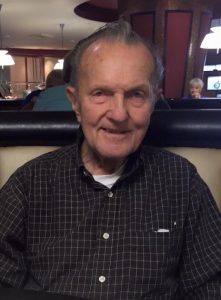 Not every person in a family is related by blood…or even by marriage. Sometimes, a lifelong friend is, in reality, as close as family. Such is the case with Burl Ford. Burl was one of the neighborhood kids that my mother, Collene Byer Spencer and her siblings played with as children. The first time I heard that they had been childhood friends, I was amazed, because by that time, we were living just down the street from Burl and his family, and in fact we were all friends, with them and their kids. Burl’s kids, Lisa, Susie, Burly, and Judy, were all in gymnastics, and his wife, Thea had learned how to coach and spot for the tumbling. So when my younger sisters and I were at their house, the natural next step was to do tumbling in their basement. It was Thea who instilled in me, the love of gymnastics, which I continued doing through high school.
Not every person in a family is related by blood…or even by marriage. Sometimes, a lifelong friend is, in reality, as close as family. Such is the case with Burl Ford. Burl was one of the neighborhood kids that my mother, Collene Byer Spencer and her siblings played with as children. The first time I heard that they had been childhood friends, I was amazed, because by that time, we were living just down the street from Burl and his family, and in fact we were all friends, with them and their kids. Burl’s kids, Lisa, Susie, Burly, and Judy, were all in gymnastics, and his wife, Thea had learned how to coach and spot for the tumbling. So when my younger sisters and I were at their house, the natural next step was to do tumbling in their basement. It was Thea who instilled in me, the love of gymnastics, which I continued doing through high school.
Cheryl remembers playing Jacks on the patio in their back yard with Burl. That is an unusual thought, because Jacks was primarily a girls game…at least in school. Burl didn’t care about that. He loved kids, and playing with his kids and the neighbor kids ![16387182_10202403016154753_4437392044467414144_n[1]](https://carynschulenberg.com/wp-content/uploads/2017/02/16387182_10202403016154753_4437392044467414144_n1-300x225.jpg) was totally within his nature…and in fact, growing up was totally not in his nature. Burl was a kid all his life. And…Burl loved his pranks!! I suppose these days he might have found himself in trouble, but those were different times. One prank, in particular, that lots of their family friends remember is the cherry bombs. In those days, kids could safely have sleep overs in someone’s back yard. The Ford’s back yard had a slight slope to it, and made for a perfect sleep over spot…in theory. You did have to take Burl into account. He would wait until we were all settled out there sleeping, and out of the blue, in the middle of the night…a cherry bomb would go off. Burl was careful of course, and never threw it near anyone, but it was something that definitely got your attention.
was totally within his nature…and in fact, growing up was totally not in his nature. Burl was a kid all his life. And…Burl loved his pranks!! I suppose these days he might have found himself in trouble, but those were different times. One prank, in particular, that lots of their family friends remember is the cherry bombs. In those days, kids could safely have sleep overs in someone’s back yard. The Ford’s back yard had a slight slope to it, and made for a perfect sleep over spot…in theory. You did have to take Burl into account. He would wait until we were all settled out there sleeping, and out of the blue, in the middle of the night…a cherry bomb would go off. Burl was careful of course, and never threw it near anyone, but it was something that definitely got your attention.
Today, we said goodbye to Burl…all of his friends and family. It was a beautiful service filled with happy 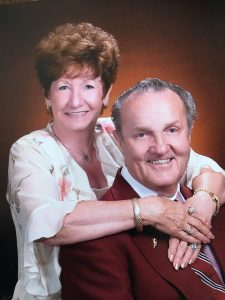 memories, and yes, the shedding of tears. Thea’s sisters reminded us of his love of sports, including the Broncos and the Colorado Rockies, as well as the Super Bowl games he got to attend, and throwing out the first pitch at a Rockies game. They told of his love of fishing, camping, snowmobiling, golf, travel, and precious time spent at their mountain cabin. And they told us about the many pranks and his bag of tricks. Burl was a member of the Oil City Slickers and Gentleman’s touch, both barber shop musical groups. The group sang at his service, and it occurred to me that, while the songs were beautiful, there was one voice missing. Those were wonderful memories, but it was something the minister said that particularly struck me as amazing. As he told of his last visits with Burl, and many before that, he said that the one thing he noticed was that Burl was always so happy and full of life. Then, he said that he wished that he could take some of Burl’s happy, joyous spirit and zest for life, and throw it out into the world. Instinctively, I thought…just pack it in a cherry bomb.
memories, and yes, the shedding of tears. Thea’s sisters reminded us of his love of sports, including the Broncos and the Colorado Rockies, as well as the Super Bowl games he got to attend, and throwing out the first pitch at a Rockies game. They told of his love of fishing, camping, snowmobiling, golf, travel, and precious time spent at their mountain cabin. And they told us about the many pranks and his bag of tricks. Burl was a member of the Oil City Slickers and Gentleman’s touch, both barber shop musical groups. The group sang at his service, and it occurred to me that, while the songs were beautiful, there was one voice missing. Those were wonderful memories, but it was something the minister said that particularly struck me as amazing. As he told of his last visits with Burl, and many before that, he said that the one thing he noticed was that Burl was always so happy and full of life. Then, he said that he wished that he could take some of Burl’s happy, joyous spirit and zest for life, and throw it out into the world. Instinctively, I thought…just pack it in a cherry bomb.
 My niece, Cassie Iverson has been into taking pictures for a while now, and lately, her husband, Chris has really been getting into photography too. Both of them have always loved nature, camping, fishing, and just enjoying time spent outdoors. I can relate to that, because my husband, Bob and I feel the same way…at least about being outdoors…not so much camping and fishing. Anyone who has spent much time relaxing in nature, will naturally be drawn to the photography of nature, because the beauty of it is something you always want to hang on to. Photography allows us to hang on to those memories. In fact, I saw a saying once that really describes the way a photographer feels, “We take photos as a return ticket to a moment otherwise gone.” Our memories can be so quickly lost, if we have done nothing to preserve them.
My niece, Cassie Iverson has been into taking pictures for a while now, and lately, her husband, Chris has really been getting into photography too. Both of them have always loved nature, camping, fishing, and just enjoying time spent outdoors. I can relate to that, because my husband, Bob and I feel the same way…at least about being outdoors…not so much camping and fishing. Anyone who has spent much time relaxing in nature, will naturally be drawn to the photography of nature, because the beauty of it is something you always want to hang on to. Photography allows us to hang on to those memories. In fact, I saw a saying once that really describes the way a photographer feels, “We take photos as a return ticket to a moment otherwise gone.” Our memories can be so quickly lost, if we have done nothing to preserve them.

I think that is something Chris and Cassie both understand. They are both very hands on parents. Having a developmentally disabled child and a child who is not disabled, is quite a handful, but they manage very well. Chris has taken to dancing around the living room with the kids. That is a cool thing, because they develop a love of music and get some exercise. I’m thankful that he is so helpful, because having kids is a lot of work, and if the dad isn’t really involved, it takes a toll on the mom. Kids need both parents to be involved in their lives, because they learn different things from each parent. They also like to have special lunches with the kids. Including the kids in activities is a great way to make the kids a part of everything. It’s all part of living life.
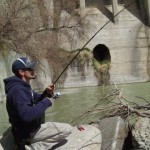 As to Chris’ own hobbies, he is a sportsman, so fishing gear and guns are simply a part of the plan. Chris likes to make sure his guns are in perfect working condition, so he makes sure they are properly cleaned. Anyone who is a gun enthusiast knows that having a dirty gun, can be bad in so many ways. It may misfire or worse, if it is not properly cleaned. I think that for most people in Wyoming, if you don’t own or appreciate guns, you are very strange. And the people in our family are definitely gun enthusiasts. Chris also likes to work on his Blazer, although it has been giving him so trouble lately. As I told Cassie, mechanics is a never ending story. There is always something that needs to be worked on. Today is Chris’ birthday. Happy birthday Chris!! Have a great day!! We love you!!
As to Chris’ own hobbies, he is a sportsman, so fishing gear and guns are simply a part of the plan. Chris likes to make sure his guns are in perfect working condition, so he makes sure they are properly cleaned. Anyone who is a gun enthusiast knows that having a dirty gun, can be bad in so many ways. It may misfire or worse, if it is not properly cleaned. I think that for most people in Wyoming, if you don’t own or appreciate guns, you are very strange. And the people in our family are definitely gun enthusiasts. Chris also likes to work on his Blazer, although it has been giving him so trouble lately. As I told Cassie, mechanics is a never ending story. There is always something that needs to be worked on. Today is Chris’ birthday. Happy birthday Chris!! Have a great day!! We love you!!

